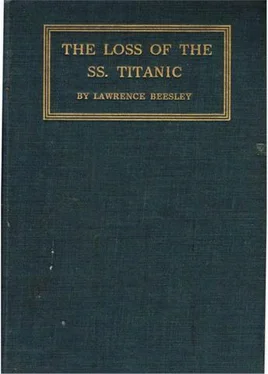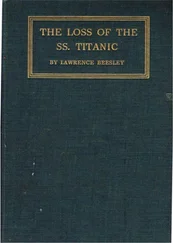But notification by Marconigram of the exact location of icebergs is a vastly different matter. I remember with deep feeling the effect this information had on us when it first became generally known on board the Carpathia. Rumours of it went round on Wednesday morning, grew to definite statements in the afternoon, and were confirmed when one of the Titanic officers admitted the truth of it in reply to a direct question. I shall never forget the overwhelming sense of hopelessness that came over some of us as we obtained definite knowledge of the warning messages. It was not then the unavoidable accident we had hitherto supposed: the sudden plunging into a region crowded with icebergs which no seaman, however skilled a navigator he might be, could have avoided! The beautiful Titanic wounded too deeply to recover, the cries of the drowning still ringing in our ears and the thousands of homes that mourned all these calamities—none of all these things need ever have been!
It is no exaggeration to say that men who went through all the experiences of the collision and the rescue and the subsequent scenes on the quay at New York with hardly a tremor, were quite overcome by this knowledge and turned away, unable to speak; I for one, did so, and I know others who told me they were similarly affected.
I think we all came to modify our opinions on this matter, however, when we learnt more of the general conditions attending trans-Atlantic steamship services. The discussion as to who was responsible for these warnings being disregarded had perhaps better be postponed to a later chapter. One of these warnings was handed to Mr. Ismay by Captain Smith at 5 P.M. and returned at the latter’s request at 7 P.M., that it might be posted for the information of officers; as a result of the messages they were instructed to keep a special lookout for ice. This, Second Officer Lightoller did until he was relieved at 10 P.M. by First Officer Murdock, to whom he handed on the instructions. During Mr. Lightoller’s watch, about 9 P.M., the captain had joined him on the bridge and discussed “the time we should be getting up towards the vicinity of the ice, and how we should recognize it if we should see it, and refreshing our minds on the indications that ice gives when it is in the vicinity.” Apparently, too, the officers had discussed among themselves the proximity of ice and Mr. Lightoller had remarked that they would be approaching the position where ice had been reported during his watch. The lookouts were cautioned similarly, but no ice was sighted until a few minutes before the collision, when the lookout man saw the iceberg and rang the bell three times, the usual signal from the crow’s nest when anything is seen dead-ahead.
By telephone he reported to the bridge the presence of an iceberg, but Mr. Murdock had already ordered Quartermaster Hichens at the wheel to starboard the helm, and the vessel began to swing away from the berg. But it was far too late at the speed she was going to hope to steer the huge Titanic, over a sixth of a mile long, out of reach of danger. Even if the iceberg had been visible half a mile away it is doubtful whether some portion of her tremendous length would not have been touched, and it is in the highest degree unlikely that the lookout could have seen the berg half a mile away in the conditions that existed that night, even with glasses. The very smoothness of the water made the presence of ice a more difficult matter to detect. In ordinary conditions the dash of the waves against the foot of an iceberg surrounds it with a circle of white foam visible for some distance, long before the iceberg itself; but here was an oily sea sweeping smoothly round the deadly monster and causing no indication of its presence.
There is little doubt, moreover, that the crow’s nest is not a good place from which to detect icebergs. It is proverbial that they adopt to a large extent the colour of their surroundings; and seen from above at a high angle, with the black, foam-free sea behind, the iceberg must have been almost invisible until the Titanic was close upon it. I was much struck by a remark of Sir Ernest Shackleton on his method of detecting icebergs—to place a lookout man as low down near the water-line as he could get him. Remembering how we had watched the Titanic with all her lights out, standing upright like “an enormous black finger,” as one observer stated, and had only seen her thus because she loomed black against the sky behind her, I saw at once how much better the sky was than the black sea to show up an iceberg’s bulk. And so in a few moments the Titanic had run obliquely on the berg, and with a shock that was astonishingly slight—so slight that many passengers never noticed it—the submerged portion of the berg had cut her open on the starboard side in the most vulnerable portion of her anatomy—the bilge. [3] See Figure 4, page 50.
The most authentic accounts say that the wound began at about the location of the foremast and extended far back to the stern, the brunt of the blow being taken by the forward plates, which were either punctured through both bottoms directly by the blow, or through one skin only, and as this was torn away it ripped out some of the inner plates. The fact that she went down by the head shows that probably only the forward plates were doubly punctured, the stern ones being cut open through the outer skin only. After the collision, Murdock had at once reversed the engines and brought the ship to a standstill, but the iceberg had floated away astern. The shock, though little felt by the enormous mass of the ship, was sufficient to dislodge a large quantity of ice from the berg: the forecastle deck was found to be covered with pieces of ice.
Feeling the shock, Captain Smith rushed out of his cabin to the bridge, and in reply to his anxious enquiry was told by Murdock that ice had been struck and the emergency doors instantly closed. The officers roused by the collision went on deck: some to the bridge; others, while hearing nothing of the extent of the damage, saw no necessity for doing so. Captain Smith at once sent the carpenter below to sound the ship, and Fourth Officer Boxhall to the steerage to report damage. The latter found there a very dangerous condition of things and reported to Captain Smith, who then sent him to the mail-room; and here again, it was easy to see, matters looked very serious. Mail-bags were floating about and the water rising rapidly. All this was reported to the captain, who ordered the lifeboats to be got ready at once. Mr. Boxhall went to the chartroom to work out the ship’s position, which he then handed to the Marconi operators for transmission to any ship near enough to help in the work of rescue.
Reports of the damage done were by this time coming to the captain from many quarters, from the chief engineer, from the designer,—Mr. Andrews,—and in a dramatic way from the sudden appearance on deck of a swarm of stokers who had rushed up from below as the water poured into the boiler-rooms and coal-bunkers: they were immediately ordered down below to duty again. Realizing the urgent heed of help, he went personally to the Marconi room and gave orders to the operators to get into touch with all the ships they could and to tell them to come quickly. The assistant operator Bride had been asleep, and knew of the damage only when Phillips, in charge of the Marconi room, told him ice had been encountered. They started to send out the well-known “C.Q.D.” message,—which interpreted means: C.Q. “all stations attend,” and D, “distress,” the position of the vessel in latitude and longitude following. Later, they sent out “S.O.S.,” an arbitrary message agreed upon as an international code-signal.
Soon after the vessel struck, Mr. Ismay had learnt of the nature of the accident from the captain and chief engineer, and after dressing and going on deck had spoken to some of the officers not yet thoroughly acquainted with the grave injury done to the vessel. By this time all those in any way connected with the management and navigation must have known the importance of making use of all the ways of safety known to them—and that without any delay. That they thought at first that the Titanic would sink as soon as she did is doubtful; but probably as the reports came in they knew that her ultimate loss in a few hours was a likely contingency. On the other hand, there is evidence that some of the officers in charge of boats quite expected the embarkation was a precautionary measure and they would all return after daylight. Certainly the first information that ice had been struck conveyed to those in charge no sense of the gravity of the circumstances: one officer even retired to his cabin and another advised a steward to go back to his berth as there was no danger.
Читать дальше












